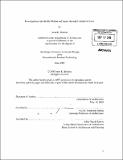Investigations into bodily motion and space through centripetal force
Author(s)
Brisson, Irene E. (Irene Elsa)
DownloadFull printable version (2.843Mb)
Other Contributors
Massachusetts Institute of Technology. Department of Architecture.
Advisor
Ann M. Pendleton-Jullian.
Terms of use
Metadata
Show full item recordAbstract
The human body interacts with spatial and solid forms constantly: adapting, negotiating, and interacting. In the context of dance, set and costume design this interdependency between motion and form is given precedent whereas in architectural design, the form of space and structure is given priority over human bodies and their motions. Dance and performance artists have used designed objects to extend the spatial consequence of the body and its motions outside of the limb-defined kinesphere; artists have created sets and installations that serve as tools, as well as obstacles, for the body to negotiate. Experimentation with weighted cloth and rope extensions explored the limits and effects of the centripetal force resulting for the orbital motion of the object on the central body. This system serves both to extend the rotation of the body further out into space and to amplify the wobble of the spinning body.
Description
Thesis: S.B. in Art and Design, Massachusetts Institute of Technology, Department of Architecture, 2005. Cataloged from PDF version of thesis. Includes bibliographical references (page 18).
Date issued
2005Department
Massachusetts Institute of Technology. Department of ArchitecturePublisher
Massachusetts Institute of Technology
Keywords
Architecture.